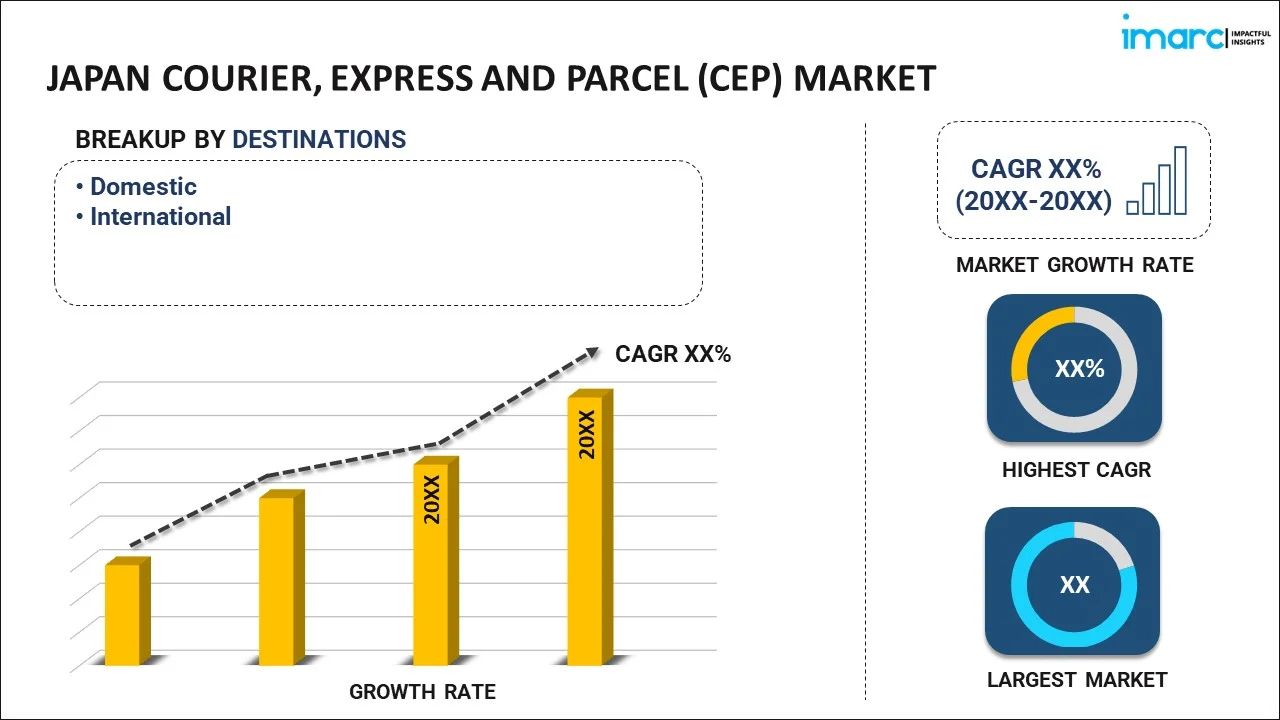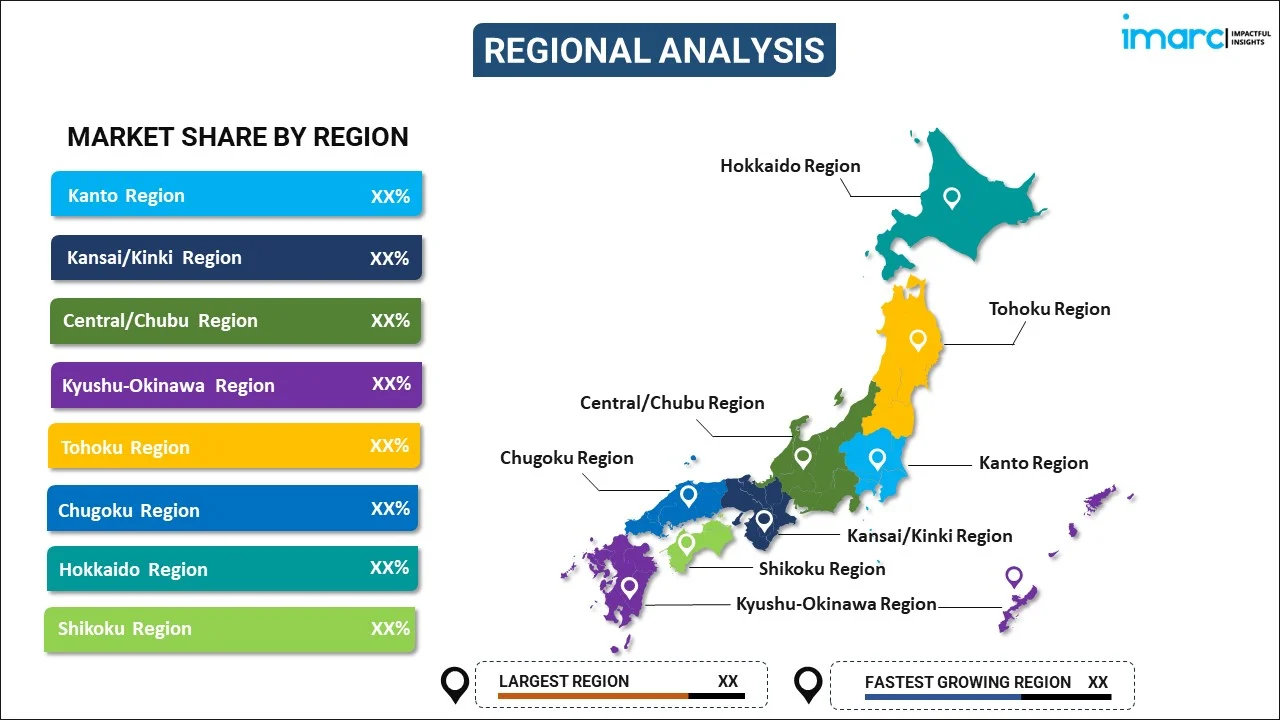
Japan Courier, Express and Parcel (CEP) Market Report by Destination (Domestic, International), Business (B2B (Business-to-Business), B2C (Business-to-Consumer)), End User (Services, Wholesale and Retail Trade, Life Sciences/ Healthcare, Industrial Manufacturing, and Others), and Region 2025-2033
Market Overview:
Japan courier, express and parcel (CEP) market size reached USD 33.1 Billion in 2024. Looking forward, IMARC Group expects the market to reach USD 97.1 Billion by 2033, exhibiting a growth rate (CAGR) of 11.56% during 2025-2033. The rising popularity of on-demand delivery and the numerous sustainability goals are primarily driving the market growth.
|
Report Attribute
|
Key Statistics
|
|---|---|
|
Base Year
|
2024
|
|
Forecast Years
|
2025-2033
|
|
Historical Years
|
2019-2024
|
| Market Size in 2024 | USD 33.1 Billion |
| Market Forecast in 2033 | USD 97.1 Billion |
| Market Growth Rate 2025-2033 | 11.56% |
Courier, express, and parcel (CEP) services refer to a spectrum of transportation and logistical strategies created to swiftly deliver packages and documents. These services are known for their promptness, dependability, and ability to be tracked. Generally, CEP companies utilize cutting-edge technologies and networks to guarantee timely delivery, frequently achieving same-day or next-day delivery. They serve both corporate and individual clients, providing various delivery choices, including worldwide shipping. CEP services are crucial to the worldwide supply chain, aiding e-commerce, manufacturing, and distribution sectors by enabling the rapid transfer of products and data.
Japan Courier, Express and Parcel (CEP) Market Trends:
The Japan courier, express, and parcel (CEP) market is currently undergoing significant expansion, primarily fueled by the rapid proliferation of e-commerce. This trend is supported by the growing preference for online shopping among consumers, leading to a notable surge in parcel shipments. Notably, the increasing number of trade activities has accentuated the necessity for efficient cross-border shipping solutions, a demand that the courier, express, and parcel companies adeptly meet through their reliable and timely international delivery services, thus fostering a positive trajectory for market growth in Japan. Additionally, the escalating expectations for same-day and on-demand delivery services among both consumers and businesses have also contributed to the flourishing of the courier, express, and parcel market, prompting companies to continuously innovate and optimize their logistical networks to meet these demands effectively. Leveraging sophisticated technologies like artificial intelligence (AI), automation, and route optimization has significantly boosted operational efficiency and customer satisfaction, thereby bolstering the overall growth of the market in Japan. Moreover, the COVID-19 pandemic has acted as a catalyst for digital transformation and the widespread adoption of e-commerce, further amplifying the expansion of the courier, express, and parcel market in Japan, as it served as a vital conduit for delivering essential goods and services during periods of lockdowns and social distancing measures. This, in turn, is expected to fuel the regional market over the forecasted period.
Japan Courier, Express and Parcel (CEP) Market Segmentation:
IMARC Group provides an analysis of the key trends in each segment of the market, along with forecasts at the country level for 2025-2033. Our report has categorized the market based on destination, business, and end user.
Destination Insights:

- Domestic
- International
The report has provided a detailed breakup and analysis of the market based on the destination. This includes domestic and international.
Business Insights:
- B2B (Business-to-Business)
- B2C (Business-to-Consumer)
A detailed breakup and analysis of the market based on the business have also been provided in the report. This includes b2b (business-to-business) and b2c (business-to-consumer).
End User Insights:
- Services
- Wholesale and Retail Trade
- Life Sciences/ Healthcare
- Industrial Manufacturing
- Others
The report has provided a detailed breakup and analysis of the market based on the end user. This includes services, wholesale and retail trade, life sciences/ healthcare, industrial manufacturing, and others.
Regional Insights:

- Kanto Region
- Kansai/Kinki Region
- Central/ Chubu Region
- Kyushu-Okinawa Region
- Tohoku Region
- Chugoku Region
- Hokkaido Region
- Shikoku Region
The report has also provided a comprehensive analysis of all the major regional markets, which include Kanto Region, Kansai/Kinki Region, Central/ Chubu Region, Kyushu-Okinawa Region, Tohoku Region, Chugoku Region, Hokkaido Region, and Shikoku Region.
Competitive Landscape:
The market research report has also provided a comprehensive analysis of the competitive landscape. Competitive analysis such as market structure, key player positioning, top winning strategies, competitive dashboard, and company evaluation quadrant has been covered in the report. Also, detailed profiles of all major companies have been provided. Some of the key players include:
- DHL (Deutsche Post AG)
- FedEx Corporation
- Japan Post Co. Ltd.
- Nippon Express Co. Ltd.
- Sagawa Express Co. Ltd.
- Seino Transportation Co. Ltd.
- Yamato Transport Co. Ltd.
(Please note that this is only a partial list of the key players, and the complete list is provided in the report.)
Japan Courier, Express and Parcel (CEP) Market Report Coverage:
| Report Features | Details |
|---|---|
| Base Year of the Analysis | 2024 |
| Historical Period | 2019-2024 |
| Forecast Period | 2025-2033 |
| Units | Billion USD |
| Scope of the Report | Exploration of Historical and Forecast Trends, Industry Catalysts and Challenges, Segment-Wise Historical and Predictive Market Assessment:
|
| Destinations Covered | Domestic, International |
| Businesses Covered | B2B (Business-to-Business), B2C (Business-to-Consumer) |
| End Users Covered | Services, Wholesale and Retail Trade, Life Sciences/ Healthcare, Industrial Manufacturing, Others |
| Regions Covered | Kanto Region, Kansai/Kinki Region, Central/ Chubu Region, Kyushu-Okinawa Region, Tohoku Region, Chugoku Region, Hokkaido Region, Shikoku Region |
| Companies Covered | DHL (Deutsche Post AG), FedEx Corporation, Japan Post Co. Ltd., Nippon Express Co. Ltd., Sagawa Express Co. Ltd., Seino Transportation Co. Ltd., Yamato Transport Co. Ltd., etc. |
| Customization Scope | 10% Free Customization |
| Post-Sale Analyst Support | 10-12 Weeks |
| Delivery Format | PDF and Excel through Email (We can also provide the editable version of the report in PPT/Word format on special request) |
Key Questions Answered in This Report:
- How has the Japan courier, express and parcel (CEP) market performed so far and how will it perform in the coming years?
- What has been the impact of COVID-19 on the Japan courier, express and parcel (CEP) market?
- What is the breakup of the Japan courier, express and parcel (CEP) market on the basis of destination?
- What is the breakup of the Japan courier, express and parcel (CEP) market on the basis of business?
- What is the breakup of the Japan courier, express and parcel (CEP) market on the basis of end user?
- What are the various stages in the value chain of the Japan courier, express and parcel (CEP) market?
- What are the key driving factors and challenges in the Japan courier, express and parcel (CEP)?
- What is the structure of the Japan courier, express and parcel (CEP) market and who are the key players?
- What is the degree of competition in the Japan courier, express and parcel (CEP) market?
Key Benefits for Stakeholders:
- IMARC’s industry report offers a comprehensive quantitative analysis of various market segments, historical and current market trends, market forecasts, and dynamics of the Japan courier, express and parcel (CEP) market from 2019-2033.
- The research report provides the latest information on the market drivers, challenges, and opportunities in the Japan courier, express and parcel (CEP) market.
- Porter's five forces analysis assist stakeholders in assessing the impact of new entrants, competitive rivalry, supplier power, buyer power, and the threat of substitution. It helps stakeholders to analyze the level of competition within the Japan courier, express and parcel (CEP) industry and its attractiveness.
- Competitive landscape allows stakeholders to understand their competitive environment and provides an insight into the current positions of key players in the market.
Need more help?
- Speak to our experienced analysts for insights on the current market scenarios.
- Include additional segments and countries to customize the report as per your requirement.
- Gain an unparalleled competitive advantage in your domain by understanding how to utilize the report and positively impacting your operations and revenue.
- For further assistance, please connect with our analysts.
 Inquire Before Buying
Inquire Before Buying
 Speak to an Analyst
Speak to an Analyst
 Request Brochure
Request Brochure
 Request Customization
Request Customization




.webp)




.webp)












